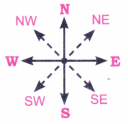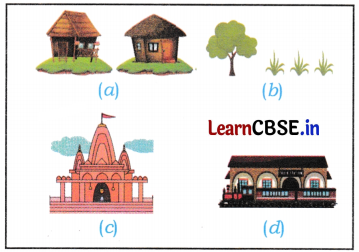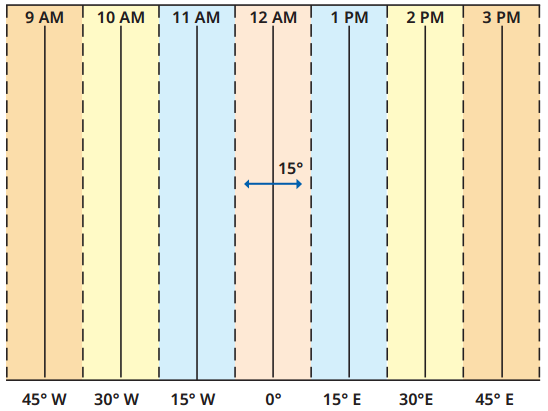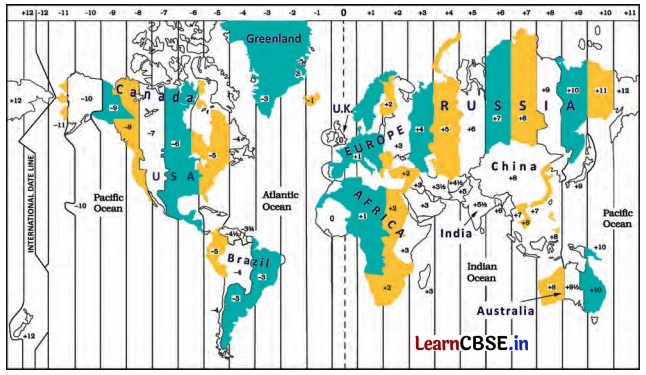Locating Places on the Earth NCERT Class 6th SST Chapter 1 Question Answer
Locating Places on the Earth Class 6 Questions and Answers
The Big Questions (Page 7)
Question 1.
What is a map and how do we use it? What are its main components?
Answer:
Map is a representation or drawing of an area of the Earth on a fiat surface whether small or large – say of a district or village or very large area like India or even the world at a specific scale.
- One map contains many facts.
- Collection of maps is called an Atlas.
Maps can be used to represent details of areas and features of the Earth.
Examples:
- Physical Maps: Physical features of the Earth such as mountains, oceans, rivers, plains and plateaus
- Political Maps: Political division of the Earth – countries, states, boundaries, capital, cities, villages etc.
- Thematic Maps: Specific information like rainfall, forests, minerals, roads, industries, population density etc.
-
The main components of maps are:
- Distance
- direction and
- symbols.
Question 2.
What are coordinates? How can latitude and longitude be used to mark any location on the Earth?
Answer:
- Coordinates are two numbers or sometimes a letter and a number (Example: Chess board) that locate a specific point on a grid.
- On a map latitudes and longitudes are referred to ’ as two coordinates of a place. They provide systematic network of lines (grid lines) upon which the position of various surface features of the Earth can be represented, located and identified.
- Latitudes are horizontal lines that measure distance North and South of the equator. Longitudes are vertical lines that measure East or West of the Prime Meridian. But there exists only one point where they intersect. By combining these two coordinates and identifying the point of intersection of latitudes and longitudes one can mark and locate any location on the earth.
Question 3.
How are local time and standard time related to longitude?
Answer:
Longitudes are related to local time and standard time as they help us to calculate time.
- Time is measured by the movement of the earth.
- The earth spins on its axis West to East making a full turn of 360° in 24 hours (rotation).
- This means 15° per hour (15° × 24 = 360°) or say 4 minutes for one degree of longitude.
- Accordingly the earth has been divided into 24 time zones of one hour each.
- Moving eastwards from the Prime Meridian we get 12 time zones, 15° apart example: 0°, 15°E, 30°E etc. and likewise westwards (example 0°, 15°W, 30°W).
- Each place has different time of sunrise and sunset.
- Places east of Prime Meridian/ Greenwich Meridian experience sunrise (day) earlier than places lying west of the Meridian.
Local time of a place is based on the longitude of that place i.e. local time varies when places are situated on different meridians.
- To solve confusion in a country every country fixes its central meridian, passing through them as the standard meridian. The standard times are organised in time zones of 15° or 7.5°.
- The local time of the meridian is considered standard for the whole country. It is called standard time.
- Example: In India the longitude of 82 ½° E is treated as the standard meridian. The local time of the Meridian is known as Indian Standard Time (IST).
- – Through an international, agreement, the local time of all places is linked to the Greenwich Mean Time. The IST is 5 hours 30 minutes ahead of GMT.
- Both local and standard time are related to longitude.
Local time refers to the time of a place as defined by the apparent motion of the Sun. Standard time is agreed time of places along the same meridian established by law in the same country.
While local time changes continuously as longitude changes, the standard time stays-the same for a specific nation.
Let’s Explore
Question 1.
On the map in Fig. 1.1 given on (Page 08)
- Mark the hospital.
- What is the meaning of blue coloured areas?


Answer:
Water bodies, lake/pond and Stream.
Which is farther away from the railway station—the school, the Nagar Panchayat or the public garden?(Page 9)-
Answer:
Public garden.
Question 2.
Draw a simple map of a school’s playground. Let us assume it is a rectangle, 40 m in length and 30m in width. Draw it precisely with your ruler on a scale of 1 cm = 10 m.
Answer:

As 1 cm = 10 m
Hence, length should be: 40 m = 4 cm on the map
width should be: 30 m = 3 cm on the map
Question 3.
Now measure the diagonal of the rectangle. How many centimetres do you get? Using the scale, calculate the real length of the playground’s diagonal, in metres. (Page 10)
Answer:
The diagonal of the rectangle is 5 cms.
So if 1 cm as per scale equals 10 metres,
Then 5 cms × 10 metres = 50 metres
The real length of the playground’s diagonal is 50 metres.
Question 4.
Consider the map of the small city again. Identify the correct and incorrect statements in the list below:
(i) The market is north of the hospital.
Answer:
False
(ii) The museum is southeast of the bank.
Answer:
True
(iii) The railway station is northwest of the hospital.
Answer:
True
(iv) The lake is northwest of the apartment blocks. (Page 11)
Answer:
False
![]()
Question 5.
Draw a rough map of your locality or your village, including your home, school and a few other important landmarks. Show the cardinal directions and use a few of the symbols shown in Fig. 1.2 on page 12 to mark some important features. (Page 11)

What do the following symbolise on a map? (Page 12)
Answer:
(a) Settlement
(b) Tree, grass
(c) Temple
(d) Railway Station
Question 6.
Using the same terms, write down your move if you play black and respond with the same move.(Page 13)
Answer:
The black side has just opened the game by moving the queen’s pawn two squares forward. The pawn has moved from, d7 to d5.
Question 7.
If the globe or atlas in your class has well-marked latitudes and longitudes, try to note down approximate values for the latitude and longitude of
(1) Mumbai,
(2) Kolkata,
(3) Singapore,
(4) Paris. (Page 17)
Answer:
Approximate latitude and longitude values of
(1) Mumbai
(2) Kolkata
(3) Singapore
(4) Paris
Question 8.
Two friends, one sitting in Porbandar (Gujarat) and the other in Tinsukia (Assam), are speaking on the phone late afternoon. The latter remarks that the sun has set in Assam and it’s now dark. The former is surprised and says, uBut it’s still full daylight here.1” Explain why. And, as a class actimty, calculate the difference in local time between those two Cities. (Hint: for now, consider the difference in longitude between Porbandar and Tinsukia to be 30°; later, you can find out the precise value.)(Page 21)
Answer:
Explanation: There is a difference of 30° between Porbandar (Gujarat) and Tinsukia (Assam). That is the local time difference is 4 min x 30° =120 minutes or 2 hours. Also the sunrises in Assam (Tinsukia) before it doesn’t Gujarat (Porbandar) as Assam is in North East of India and Gujarat in West of India.
The time both cities follow is the 1ST set at 82V2° E. SO while the standard time is the same the sun rise and sun set follows local time.
Calculation:
Tinsukia is 30° East of Porbandar
Since 1 ° = 4 minutes
30° = 4 minutes × 30 = 120 min.
= 120 minutes ÷ 6Q = 2 hours.
The time difference in local time is of 2 hours.

Question 9.
Return to the two friends sitting in Gujarat and Assam. Use this example to explain the Difference in local time and standard time. (Page21)
Answer:
While local time varies with longitude standard time always stays the same in the whole country at a particular moment no matter where you are (as it is fixed as per the standard meridian).
Source-Based Questions (See passage on page 17)
Question 1.
(i) Is Greenwich the 1st prime meridian?
Answer:
No
(ii) What was India’s prime meridian centuries ago?
Answer:
‘Madhya Rekha’ (or middle line).
(iii) The ancient India’s own prime meridian passed through which old city?
Answer:
Ujjayini (today’s Ujjain).
(iv) Why was this meridian famous?
Answer:
It was a reference for calculations in all Indian astronomical texts.
(v) Give the name of the famous Indian astronomer who lived 1500 years ago in the city.
Answer:
Varahamihira.

![]()
Don’t Miss Out
Question 1.
As you can see on the globe of meridians of longitudes, 180°W and 180°E are the same longitude; so this longitude is noted 180°, omitting the letter W or E. (Page 16)
Answer:

- Yes the 1800 longitude is not marked 180° E or 180°W as other meridians East or West of the Prime Median (0°).
- The 180° longitude is called the International Date Line opposite the Prime Meridian.
- Crossing the IDL changes the date by one day.
- If you cross to its East you add a day.
- If you cross to its West you subtract a day.
- You would have heard people say they reached the US from India on the same day because for the US we have to cross the imaginary IDL. While India has to the East of the IDL USA is to the West of the IDL 0°.
Question 2.
Do all countries have one standard time.
Give examples of any 2 countries which have more than one time zone.
Why do these countries have more time zones.
Answer:
- Not all but most countries have one time zone.
- Russia has 11 time zones and USA has 6 time zones.
- These countries have more time zones because of the longitudinal extent.
Questions, Activities and Projects (Pages 24-25)
Question 1.
Returning to page 10 and to Fig. 5.2 in Chapter 5 of this textbook, taking the scale to be 2.5 cm = 500km, calculate the real distance from the estuary of the Narmada River to the estuary of the Ganga river. (Hint: round off your measurement on the map to an easy number.)
Answer:
Distance between estuary of river Narmada and if river Ganga is 10 cms. So if 2.5 cms is equal to 500 kms as ground 10cms will be 500 km × 4 = 2,000 kms.
Question 2.
Why is it 5:30 pm in India when it is 12 pm or noon. in London?
Answer:
It is 5.30 pm in India when it is 12 pm or noon in London because:
- London is located at 0° longitude, (the Prime meridian).
- In India 82%°E longitude is standard meridian and time on this meridian is standard time in India (1ST).
- Time in India is ahead of London. Time difference is 4 minutes for every 1° of longitude towards east.
-
Hence in India – 82 ½° ÷ 4 minutes
= 330 minutes
i.e. 330 ÷ 60 = 5 hours 30 minutes.
Question 3.
Why do we need symbols and colours in the map?
Answer:
Symbols and colours are important component of maps and are needed in maps because:
- It is not possible to draw actual shape and size of different features say like buildings, roads, temples, rivers, mountains etc. due to lack of space, so we use various symbols and colours to show these features.
- In this way numerous details and more information can be shown in limited space.
- Symbols and colours enable easy understanding of maps by a variety of users.
- They help tide over language barriers as maps have a universal language. These are called conventional symbols.
- The Survey of India, a government body, has fixed a set of symbols and colours for maps of India.
Question 4.
Find out what you have in the eight directions from your home or school.
Answer:
Do it yourself.
Example: South Extension II in New Delhi.

- North: INA Market
- North East: Defence Colony
- East: Nature Basket
- South East: Gautam Nagar
- South: Asiad Village
- South West: Ansal Plaza
- West: Yusuf Sarai
![]()
Question 5.
What is the difference between local time and standard time? Discuss it in groups,with each group writing an answer in 100 to 150 words. Compare the answers.
Answer:
- Both local time and standard time are based on meridiAnswer:
- Local.time is based on the local meridian passing through that place. The places lying North and South on the same meridian will have the same local time. On the other hand the places lying East or West of that meridian will have different local times. It varies by 4 minutes for every 1° of Prime meridian East or West. While in the East it is plus 4 minutes going West from Prime Meridian it is 4° behind. (If it is 12 noon at Greenwich it would be 12.04 pm in the 1° East and 11.56 a.m. in the 1° west).
- Standard time is local time of a meridian of longitude which is considered valid for the whole country. This meridian is called Standard Meridian of the country. Example in Indian Standard Meridian is 82 ½°E and time on it is Indian Standard Time (1ST). [For more detail students can lookup. The Big Question 3]
Question 6.
Delhi’s and Bengaluru’s latitudes are 29°N and 13°N; their longitudes are almost the same, 77°E. How much will be the difference in local time between the two cities?
Answer:
No difference in local time of the two cities Delhi and Bengaluru as both i.e. almost on the same meridian of longitude as longitudes mark time and define time zones not latitudes.
Question 7.
Mark the following statements as true or false; explain your answers with a sentence or two.
(a) All parallels of latitude have the same length.
Answer:
False.
Explanation: The earth is almost like a sphere and latitudes are imaginary horizontal lines — complete circles that remain equidistant from each other. The Earth bulges at the equator and flattens at the poles. They vary in size from the longest at the equator (great circle) to the smallest, and are just points at the North and South pole.
(b) The length of a meridian of longitude is half of that of the Equator.
Answer:
True.
Explanation: All meridians are of equal length, and approximately half the length of the equator. All meridians converge at the poles and are true North South lines.
(c) The South Pole has a latitude of 90°S.
Answer:
True.
Explanation: Imaginary lines of latitude are labelled 90°N and 90°S of the equator (0°). The South pole is the southern most point on Earths. It is the precise point of the southern intersection of Earth’s axis and Earth’s surface.
(d) In Assam, the local time and the IST are identical.
Answer:
False.
Explanation: It is false because IST is calculated on the standard Meridian of 82½°E, while Assam is further east of the 82½°E meridian. Since local time changes every 1° by 4 minutes, the local time of Assam and IST cannot be the same.
However, Assam uses IST as standard time because all states and UT in India follows IST to maintain consistency.
(e) Lines separating the time zones are identical with meridians of longitude.
Answer:
True.
Explanation: Time zones are spaces of 15° of longitude that change by one hour with regard to the local time. As the circle has 360°, there are 24 time zones pertaining to 24 hours that are in a day. Thus time zones are identical with meridian of longitude – 0°, 15°, 30°, 45°, 60°, 75°, till 180° Eastwards and Westwards.
(f) The Equator is also a parallel of latitude.
Answer:
True.
Explanation: The equator is the most well known parallel of latitude. At 0° latitude running east to west it equally divides the Earth into the Northern and Southern hemispheres. The equator is also known as the great circle. From the equator size of parallels of latitudes decreases both Northwards and Southwards.
(g) Solve the crossword below.

Across
1. Lets you squeeze a huge area into your map
4. A convenient sphere
5. The longest parallel of latitude
6. The place the Prime Meridian is attached to
8. So convenient to find your way
10. A measure of the distance from the Equator11
Down
2. A measure of the distance from the Prime Meridian
3. These two together allow us to locate a place
6. What latitudes and longitudes together create
7. The time we all follow in India
9. These two are poles apart
11. An abbreviation for a line across which the day and date change.
Answer:

Class 6 Social Science Question Answer
- Chapter 1 Locating Places on the Earth
- Chapter 2 Oceans and Continents
- Chapter 3 Landforms and Life
- Chapter 4 Timeline and Sources of History
- Chapter 5 India, That is Bharat
- Chapter 6 The Beginnings of Indian Civilisation
- Chapter 7 India’s Cultural Roots
- Chapter 8 Unity in Diversity, or ‘Many in the One’
- Chapter 9 Family and Community
- Chapter 10 Grassroots Democracy Part 1 Governance
- Chapter 11 Grassroots Democracy Part 2 Local Government in Rural Areas
- Chapter 12 Grassroots Democracy Part 3 Local Government in Urban Areas
- Chapter 13 The Value of Work
- Chapter 14 Economic Activities Around Us